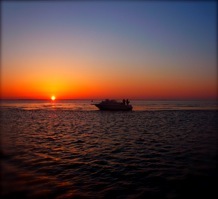 Have you ever wondered why fish seem to turn on and off at different times during the day? If you’re like me you’ve probably gone for hours without catching a fish, hardly even getting a strike. Then, click, just like turning on a light switch every cast results in a fish. Fishermen refer to this phenomenon as “the bite,” as in, “The bite turned-on about 3:00 PM and off at dark.”One significant reason why biting fish turn on and off is tidal current. Moving water pushes food sources around and triggers striped bass to begin feeding. It makes it easier for them to ambush bait that is being swept along by the flow of water. It also opens up new areas where fish can stalk their prey. Perhaps more importantly, it imparts natural action to the fishing lure causing it to be presented in a more realistic way. Striped bass start feeding when the current picks up, and become inactive when the flow slows down.
Have you ever wondered why fish seem to turn on and off at different times during the day? If you’re like me you’ve probably gone for hours without catching a fish, hardly even getting a strike. Then, click, just like turning on a light switch every cast results in a fish. Fishermen refer to this phenomenon as “the bite,” as in, “The bite turned-on about 3:00 PM and off at dark.”One significant reason why biting fish turn on and off is tidal current. Moving water pushes food sources around and triggers striped bass to begin feeding. It makes it easier for them to ambush bait that is being swept along by the flow of water. It also opens up new areas where fish can stalk their prey. Perhaps more importantly, it imparts natural action to the fishing lure causing it to be presented in a more realistic way. Striped bass start feeding when the current picks up, and become inactive when the flow slows down.
All predatory fish use current to their advantage. When I was uncovering the secrets of bass fishing on the TVA lakes of the southeast I learned from my father to pay attention to the generating schedules of the local dams. Although the big lakes are usually devoid of significant current, hydroelectric generation provides slight movement in the water and turns the fish on. I discovered that I could predict the currents with some accuracy even though I often fished as much as fifty miles upstream from the nearest dam. Timing my trips around the generating schedule and the associated feeding patterns added a new dimension to my fishing and resulted in many satisfying days on the water.
Chesapeake Tides
No place is current more important to successful fishing than on the Chesapeake Bay. Using the tide cycles and related currents to your advantage can make the difference between casting and catching. It’s one of the primary factors in how good anglers select their fishing locations and even determines where they cast their lures. In order to effectively grasp the influence of tides on fishing it’s important to understand something about how tides ebb and flood through the Bay.
Ocean tides are caused by the gravitational pull of the sun and moon. As the earth rotates, the sun and moon pulls the water upward creating gigantic humps on the surface of the water. As a result of this upheaval, depressions are formed on either side of the humps. As the sun and moon pass over the earth at different times, two distinct tidal sessions are created with the gravitational pull of the moon (which is much closer) resulting in the stronger of the two tides and a bigger hump. Since the water has to flow somewhere, it flows away from the humps toward the depressions creating ocean currents.
At times the gravitational forces of the sun and moon work in concert to produce more dramatic tides and stronger currents. This happens during the full and new moons when high tides are higher and low tides are lower. These increased periods of tidal flow are called spring tides. Alternately, during the first and third quarter phase the sun and moon are opposite each other and cancel each other’s effect resulting in neap tides or periods when tidal changes are less obvious and currents are reduced.
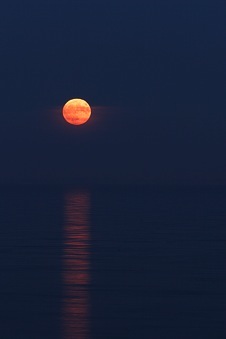 The currents caused by the tidal humps create a wave that flows toward the shore. As the wave enters the Chesapeake at its mouth near Cape Henry, it is funneled into a relatively narrow and shallow area and moves all-at-once up the Bay. Similar to a breaker moving toward the beach, the tidal wave pulls water in front of it and crests upward as it maintains intensity and flows northward up the Bay. The top part of the wave is the high tide, and the trough in front is the low.
The currents caused by the tidal humps create a wave that flows toward the shore. As the wave enters the Chesapeake at its mouth near Cape Henry, it is funneled into a relatively narrow and shallow area and moves all-at-once up the Bay. Similar to a breaker moving toward the beach, the tidal wave pulls water in front of it and crests upward as it maintains intensity and flows northward up the Bay. The top part of the wave is the high tide, and the trough in front is the low.
The wave is much too long and low to see, but imagining it moving along the Chesapeake can be very helpful in understanding how currents flow. Once the wave reaches the top of the Bay the water must recede back toward the ocean creating current in the opposite direction. On most days the Maryland part of the Bay receives two tidal waves resulting in two high tides and two low tides or four distinct periods of incoming and outgoing tidal flow. Incoming current is called a “flood” tide, and an outgoing tide is said to “ebb.”
Modification of the Flow
Since the Chesapeake Bay is relatively narrow and shallow, there are significant outside influences that affect the intensity of the tidal flow. One such influence is topography. In areas where the bay is shallower or narrower water must flow faster as the wave rushes through. A good example of this increase can be seen at Kent Narrows or other places between two islands where water is funneled. Current is also faster in the main channel of the bay in areas where the shoreline is closest together such as the area around the Bay Bridge.
One of the biggest influences to the speed and volume of the tidal current is the weather. Tides that are influenced by weather are called meteorological tides. The weather has a dramatic effect on Chesapeake Bay currents. For example, east or west winds can pile up water on one side of the bay or the other. As the wind subsides the water rushes back toward the opposite side creating distinct changes in the normal flow. Sustained north or south winds have an even more dramatic effect. They push water from the Atlantic Ocean in or out of the Bay resulting in substantially increased or decreased flow. Sometimes the influence of big storms off the coast can actually cancel out a high or low tide and by the same token create tidal surges that result in significant coastal flooding.
Other factors influencing tidal currents are the influx of water from the tributaries, especially the bigger rivers of the Upper Bay during the spring. Smaller tidal waves entering from the Chesapeake & Delaware Canal also have an impact. Finally, changes in barometric pressure can influence how the current flows through the Bay. It is not unusual for the effects of weather to completely mask the normal astronomical tide cycle in the Chesapeake.
Predicting the Flow
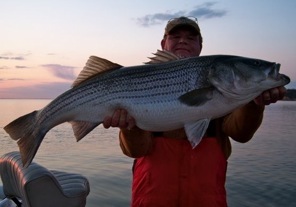 Because of the consistent way the sun and moon moves across the earth tides can be easily predicted. Tide tables that provide high and low predictions at specific waypoints can be found in local newspapers or magazines and at various web sites. It’s important to understand that high tide isn’t the same as high current and low tide doesn’t mean low flow. Just like the breaker crashing on to the beach, current is strongest just before the high point of the wave and strong again when the water starts flowing back toward the sea. Current rests at the points when the wave is changing, after it’s moved through and the flow is beginning to reverse.
Because of the consistent way the sun and moon moves across the earth tides can be easily predicted. Tide tables that provide high and low predictions at specific waypoints can be found in local newspapers or magazines and at various web sites. It’s important to understand that high tide isn’t the same as high current and low tide doesn’t mean low flow. Just like the breaker crashing on to the beach, current is strongest just before the high point of the wave and strong again when the water starts flowing back toward the sea. Current rests at the points when the wave is changing, after it’s moved through and the flow is beginning to reverse.
In order to get a good idea of how current relates to the predicted high and low tides I’ve found it helpful to always look at a the same specific tide prediction station then note my observations at my favorite fishing spots over time. For example, in normal conditions I’ve found that I’ll have the best flow at the center of the Bay Bridge within 90 minutes of the predicted high or low tide at Sandy Point State Park. I also know that I’ll keep current for approximately two hours past the predicted high or low. Remember that high tide is the crest of the wave, but the wave keeps moving forward long after it crests. In other words, if high tide is predicted to occur at 10:00 AM, I can be relatively sure that I’ll have flooding current until about noon. If low tide is predicted to be at 6:00 PM, the current should ebb until about 8:00 PM. That rule won’t hold exactly true for anywhere else since the width and depth of the Bay and other influences will be different depending on the location, but it can provide a good idea of how to use the tide tables to predict tidal current where you fish.
In addition to tide tables there are current prediction graphs which are available on web sites and published in fishing magazines. While these can be somewhat helpful, the predictions usually don’t figure weather events or river currents into the equation. Look at them as a rough guide of what conditions might be like, but don’t bet your fishing trip on them. They are frequently inaccurate.
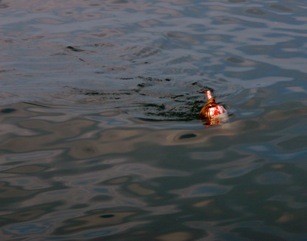 Riding the Wave
Riding the Wave
Few anglers have the luxury of fishing only during times of optimum current. Most of us fish when we can get out, regardless of the tide cycle. Nevertheless, it’s possible to make the tides work for you no matter when you go fishing. Here’s how. Say you are catching fish at the Bay Bridge rock piles with a substantial outgoing current. As the current wanes the bite starts to fall off. In order to keep catching fish you have to make a decision regarding a new fishing spot. Going north would be counterproductive because you’d actually be moving away from the strongest current flow, but you could point your boat south and actually catch up with the tidal wave arriving at your new location at just the optimum time to find actively feeding fish. Once the bite slows down at this spot, you can continue the process continuing to move south with the wave. Since you usually can’t follow the wave all the way down the bay, moving to areas where the bay is narrower such as river mouths or around islands would be a good strategy during periods of slack current while you’re waiting for the next wave to arrive. The ability to ride the tidal wave is what separates good light-tackle fishermen from mediocre ones.
Given that currents can be somewhat unpredictable, especially when the weather is unsettled, paying attention to what is going on around you can be very helpful. Varying conditions can cause the current to flow in opposite directions on either side of the Bay. There’s no substitute for experience in knowing when this will occur. It pays to ride around and familiarize yourself with how the flow is affected in different situations. It might be easier to move to a location on the other side of the Bay than to run several miles north or south to follow the wave.
Casting with the Flow
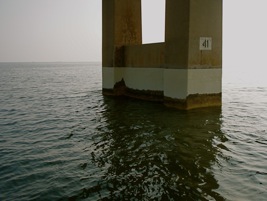 Another important aspect of making current work for you involves where you cast your lures. The fisherman’s objective is to present the bait as naturally as possible, so the ability to read the current and recognize how it affects your lure at specific locations is essential. Anyone who has ever fished a river or small stream knows that it’s far more effective to wade upstream and cast ahead of where you are standing. The same principle applies to fishing the Chesapeake Bay. Whenever possible fish will face up-current and position themselves near structure where they can ambush bait as it sweeps by. Therefore, it’s essential to cast upstream and well above where you think the fish might be holding.
Another important aspect of making current work for you involves where you cast your lures. The fisherman’s objective is to present the bait as naturally as possible, so the ability to read the current and recognize how it affects your lure at specific locations is essential. Anyone who has ever fished a river or small stream knows that it’s far more effective to wade upstream and cast ahead of where you are standing. The same principle applies to fishing the Chesapeake Bay. Whenever possible fish will face up-current and position themselves near structure where they can ambush bait as it sweeps by. Therefore, it’s essential to cast upstream and well above where you think the fish might be holding.
This is especially important when casting top-water plugs around shoreline points. Identify the area near the point where the current is strongest. Often there will be a small rip caused by the current or wind. It will be where the pattern of the waves changes. If there is no wind or waves, look for small ripples on the surface. Cast above it and work your lure downstream at approximately the same speed as the current. Once your lure reaches the rip, look out. That’s the most likely location for the fish.
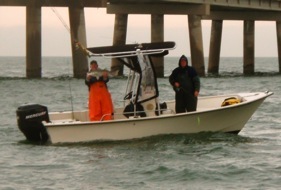 When fishing around deep structure or bridge pilings it’s best to keep your boat on the down-current side of the underwater object. Running the boat across the area will put the fish on-guard and alert them to your presence. Stay as quiet as possible and maintain your position downstream, casting up just far enough to allow your lure to sink down into the strike zone around the structure. Jigging against the current may trigger an occasional impulse strike, but it rarely produces big fish consistently. Keep that technique in mind when selecting your fishing spots. Some locations produce more current on an outgoing tide while others might be better on an incoming. Plan accordingly for big rewards.
When fishing around deep structure or bridge pilings it’s best to keep your boat on the down-current side of the underwater object. Running the boat across the area will put the fish on-guard and alert them to your presence. Stay as quiet as possible and maintain your position downstream, casting up just far enough to allow your lure to sink down into the strike zone around the structure. Jigging against the current may trigger an occasional impulse strike, but it rarely produces big fish consistently. Keep that technique in mind when selecting your fishing spots. Some locations produce more current on an outgoing tide while others might be better on an incoming. Plan accordingly for big rewards.
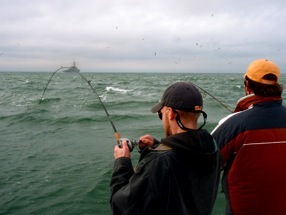 Although it’s unusual, it’s possible for the current to get too strong at some locations. Rockfish love fast moving water and have no problem maneuvering around in swift currents when they are actively feeding. But there are times during sustained high currents when fish will be resting and conserving energy away from the strongest flows. In these conditions look for eddies or areas where the current breaks on either side of the fastest water. Even though they aren’t actively seeking food, it’s still possible to induce a strike from these fish with a properly presented bait.
Although it’s unusual, it’s possible for the current to get too strong at some locations. Rockfish love fast moving water and have no problem maneuvering around in swift currents when they are actively feeding. But there are times during sustained high currents when fish will be resting and conserving energy away from the strongest flows. In these conditions look for eddies or areas where the current breaks on either side of the fastest water. Even though they aren’t actively seeking food, it’s still possible to induce a strike from these fish with a properly presented bait.
Summary
Recognizing the effects of moving current on the behavior of feeding stripers may be the single most important aspect of successful fishing. Although a significant amount of fieldwork can be required to identify current patterns as they relate to specific locations, an alert angler can usually find a good place to fish simply by observing the water flow. Currents affect where striped bass will feed, and dictate the best techniques for catching them. Every good Chesapeake Bay fisherman I know is a student of tidal patterns and the effect of current flow on their fishing. Using the tide cycles to concentrate your efforts can make a dramatic difference in your light tackle fishing. It allows you to pick your spots at the optimum times and maximize your chances for catching big fish any time you’re on the water.




Great info.
Hey Shawn,
Great new web page design and looks. I’v read your Fishing reports and your fishing articles but I get confused between fishing structure, upcurrents, and drop offs. When fishing drop offs, and ledges, where does one position the boat to start casting and jigging, is it the upcurrent or downcurrent side? Your comments on fishing the river, upstream is …. to me.
Topwater: cast upcurrent and work lure downstream? right?
WHen fishing Tolley Point, and the tide is going out, are the fish on the north side of the point, facing upstream/upcurrent like on the BB rocks?
are the rock sitting south of the bar, or just off the bar and over the ledge in deeper water, downstream?
If so, do i position the boat over the deeper edge water, caset upcurrent, and let the jig drop off from the point, into the deeper water?
Thanks,
Rick
Good questions, Rick. When jigging structure, the optimum position is to set your boat so that you’re throwing upstream into the current and the lure is swimming back toward you in the same direction the current is flowing.
That can get tricky when it’s windy, so sometimes you just have to go with the way the boat is drifting. On very windy days, face into the wind and cast at whatever angle you can find that will get your jig to the bottom, then let the wind help keep your lure moving but always maintain contact with the bottom. You may need to let out line to do that. Once the lure gets too far back it will naturally ride up and lose the bottom so you have to reel in and repeat.
You’re right on the topwater casting, but it’s not as critical that a surface lure move with the current (although it helps). Fish stage at different places around points, but when they’re feeding they’re usually closest to the “rip,” that is the area where either the current or the wind causes the water to start rippling. Try fan casting on either side, but that rip is the best strike zone. If there is cover such as rocks, etc. cast up-current so the lure comes popping downstream very close to the cover.
Good luck!
-Shawn
I have found that fish will stage on the up current side of pilings or what I call the bubble. This is true at the CBBT. Having done a great deal of smallmouth fishing on the Susquehanna, smallies will also “at times” hang out in the bubble in front of large boulders. That said I will try and find out where the fish are and present to them. Do you ever find the fish primaraly hanging on the up current side at the Bay Bridge? Do you think that the smaller more agressive fish may stage closer to or upcurrent more then the larger fish? I live about a 8 mike run to Tangier on the Eastern Shore of VA and fish Pocomoke and Tangier sounds alot. Just moved hear from Lancaster PA 2 years ago. Looking forward to many jigging and eeling trips to the CBBT in then upcoming weeks. Great site with very good information that makes one think. Thanks
Find great Pec Workouts!…
[…]Riding the Wave – Make Current Work For You | Chesapeake Light Tackle[…]…